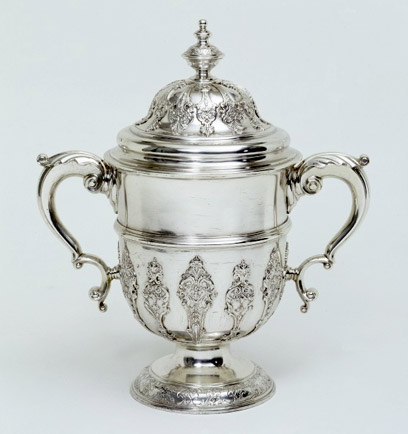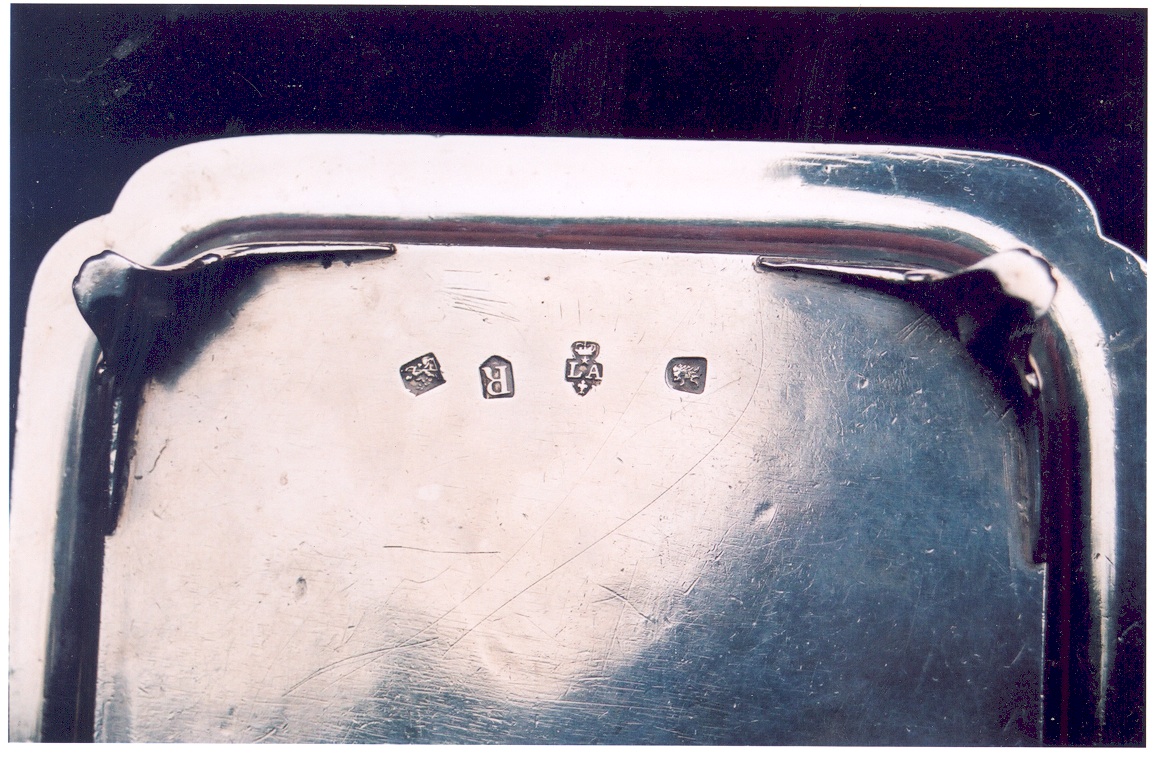Paul de Lamerie on:
[Wikipedia]
[Google]
[Amazon]
 Paul de Lamerie (9 April 1688 – 1 August 1751) was a London-based
Paul de Lamerie (9 April 1688 – 1 August 1751) was a London-based


 In August 1703, de Lamerie became the
In August 1703, de Lamerie became the
accessed
*Ellenor Alcorn, ''Beyond the Maker's Mark: Paul de Lamerie Silver in the Cahn Collection,'' Cambridge: John Adamson 2006 . *John F. Hayward, ''Huguenot Silver in England, 1688—1727''. London 1959. *P.A.S. Phillips, ''Paul de Lamerie'', London 1935.
Paul de Lamerie
*http://www.christies.com/features/2010-may-the-greatest-goldsmith-732-1.aspx *http://www.collectorsweekly.com/articles/the-four-georges-notes-on-english-domestic-silver/ * {{DEFAULTSORT:Lamerie, Paul de 1688 births 1751 deaths Burials at St Anne's Church, Soho English goldsmiths English silversmiths Huguenots
 Paul de Lamerie (9 April 1688 – 1 August 1751) was a London-based
Paul de Lamerie (9 April 1688 – 1 August 1751) was a London-based silversmith
A silversmith is a metalworker who crafts objects from silver. The terms ''silversmith'' and ''goldsmith'' are not exactly synonyms as the techniques, training, history, and guilds are or were largely the same but the end product may vary grea ...
. The Victoria and Albert Museum
The Victoria and Albert Museum (often abbreviated as the V&A) in London is the world's largest museum of applied arts, decorative arts and design, housing a permanent collection of over 2.27 million objects. It was founded in 1852 and nam ...
describes him as the "greatest silversmith working in England in the 18th century". He was being referred to as the ‘King’s silversmith’ in 1717. Though his mark raises the market value of silver
Silver is a chemical element with the symbol Ag (from the Latin ', derived from the Proto-Indo-European ''h₂erǵ'': "shiny" or "white") and atomic number 47. A soft, white, lustrous transition metal, it exhibits the highest electrical ...
, his output was large and not all his pieces are outstanding. The volume of work bearing de Lamerie's mark makes it almost certain that he subcontracted orders to other London silversmiths before applying his own mark.
Early and private life
De Lamerie was born in's-Hertogenbosch
s-Hertogenbosch (), colloquially known as Den Bosch (), is a city and municipality in the Netherlands with a population of 157,486. It is the capital of the province of North Brabant and its fourth largest by population. The city is south of th ...
in the United Provinces (now the Netherlands). He was the son of a minor French nobleman, Paul Souchay de la Merie, a Huguenot
The Huguenots ( , also , ) were a religious group of French Protestants who held to the Reformed, or Calvinist, tradition of Protestantism. The term, which may be derived from the name of a Swiss political leader, the Genevan burgomaster Be ...
who left France following the Edict of Fontainebleau
The Edict of Fontainebleau (22 October 1685) was an edict issued by French King Louis XIV and is also known as the Revocation of the Edict of Nantes. The Edict of Nantes (1598) had granted Huguenots the right to practice their religion without s ...
in 1685. His father became an officer in the army of William III of Orange
William III (William Henry; ; 4 November 16508 March 1702), also widely known as William of Orange, was the sovereign Prince of Orange from birth, Stadtholder of Holland, Zeeland, Utrecht, Guelders, and Overijssel in the Dutch Republic from ...
and moved to London in 1689 during the Glorious Revolution, but died a pauper in 1735.
He married Louisa Juliott on 11 February 1717. They had two sons and four daughters together; three daughters survived.
Paul de Lamerie died in London and was buried at St Anne's Church, Soho
Saint Anne's Church serves in the Church of England the Soho section of London. It was consecrated on 21 March 1686 by Bishop Henry Compton as the parish church of the new civil and ecclesiastical parish of St Anne, created from part of the pari ...
. There is a memorial plaque at the site of his workshop, 40 Gerrard Street, which was unveiled on 16 January 1992.City of Westminster green plaques
Career


 In August 1703, de Lamerie became the
In August 1703, de Lamerie became the apprentice
Apprenticeship is a system for training a new generation of practitioners of a trade or profession with on-the-job training and often some accompanying study (classroom work and reading). Apprenticeships can also enable practitioners to gain a ...
to a London goldsmith
A goldsmith is a metalworker who specializes in working with gold and other precious metals. Nowadays they mainly specialize in jewelry-making but historically, goldsmiths have also made silverware, platters, goblets, decorative and servicea ...
of Huguenot origin, Pierre Platel (1659–1739). De Lamerie opened his own workshop in 1713 and was appointed goldsmith to George I George I or 1 may refer to:
People
* Patriarch George I of Alexandria (fl. 621–631)
* George I of Constantinople (d. 686)
* George I of Antioch (d. 790)
* George I of Abkhazia (ruled 872/3–878/9)
* George I of Georgia (d. 1027)
* Yuri Dolgor ...
in 1716. He worked in partnership with Ellis Gamble - formerly apprentice to Master William Hogarth
William Hogarth (; 10 November 1697 – 26 October 1764) was an English painter, engraver, pictorial satirist, social critic, editorial cartoonist and occasional writer on art. His work ranges from realistic portraiture to comic strip-like ...
- between 1723 and 1728. His early work is in the simple Queen Anne-styles, following classical French models, but de Lamerie is noted for his elaborate Rococo
Rococo (, also ), less commonly Roccoco or Late Baroque, is an exceptionally ornamental and theatrical style of architecture, art and decoration which combines asymmetry, scrolling curves, gilding, white and pastel colours, sculpted moulding, ...
style of the 1730s, particularly the richly decorated works of an unidentified craftsman, the Maynard Master.
Leaving his first premises in Great Windmill Street he moved to 40 Gerrard Street in 1738. Here he lived and probably had his shop, his workshops being in one of the 48 properties he owned in the area.
His customers included Tsarinas Anna and Catherine
Katherine, also spelled Catherine, and other variations are feminine names. They are popular in Christian countries because of their derivation from the name of one of the first Christian saints, Catherine of Alexandria.
In the early Christ ...
, Count Aleksey Bobrinsky, Sir
''Sir'' is a formal honorific address in English for men, derived from Sire in the High Middle Ages. Both are derived from the old French "Sieur" (Lord), brought to England by the French-speaking Normans, and which now exist in French only as ...
Robert Walpole, the Earl of Ilchester
Earl of Ilchester is a title in the Peerage of Great Britain. It was created in 1756 for Stephen Fox, 1st Baron Ilchester, who had previously represented Shaftesbury in Parliament. He had already been created Baron Ilchester, of Ilchester in ...
, the Earl of Thanet
Earl of the Isle of Thanet, in practice shortened to Earl of Thanet, was a title in the Peerage of England. It was created in 1628 for Nicholas Tufton, 1st Baron Tufton. He had already succeeded as second Baronet of Hothfield in 1631 and been cre ...
, Viscount Tyrconnel
Viscount Tyrconnel was a title in the Peerage of Ireland. It was created in 1718 for Sir John Brownlow, 5th Baronet, Member of Parliament for Grantham and Lincolnshire. He was made Baron Charleville, in the County of Cork, at the same time, also ...
, the Duke of Bedford
Duke of Bedford (named after Bedford, England) is a title that has been created six times (for five distinct people) in the Peerage of England. The first and second creations came in 1414 and 1433 respectively, in favour of Henry IV's third so ...
, and other members of the English aristocracy. He also worked for King John V of Portugal
Dom John V ( pt, João Francisco António José Bento Bernardo; 22 October 1689 – 31 July 1750), known as the Magnanimous (''o Magnânimo'') and the Portuguese Sun King (''o Rei-Sol Português''), was King of Portugal from 9 December 17 ...
before losing favour to the Germains of Paris. One of his productions to the Portuguese Court was a huge solid silver bath tub lost in the great 1755 Lisbon earthquake
The 1755 Lisbon earthquake, also known as the Great Lisbon earthquake, impacted Portugal, the Iberian Peninsula, and Northwest Africa on the morning of Saturday, 1 November, Feast of All Saints, at around 09:40 local time. In combination with ...
.
He served on Goldsmiths' Company
The Worshipful Company of Goldsmiths, commonly known as the Goldsmiths' Company and formally titled The Wardens and Commonalty of the Mystery of Goldsmiths of the City of London, is one of the Great Twelve Livery Companies of the City of Londo ...
committees although never became Prime Warden. He also served as Captain and then Major in the Westminster Volunteers.
The Ashmolean Museum in Oxford has the Treby toilet service
A toilet service is a set of objects for use at the dressing table. The term is usually reserved for large luxury sets from the 17th to 19th centuries, with toilet set or vanity set used for later or simpler sets. Historically, services were ...
(29 pieces, London, 1724-1725).
A two-handled silver cup and cover by Paul de Lamerie, dated 1720, was among the wedding gifts of Queen Elizabeth II.
Lawsuit
Famously, in 1722 a chimney sweep's boy sued de Lamerie after he found a jewel and took it to de Lamerie's shop to have it valued. When the boy asked for the jewel back, de Lamerie's apprentice only returned the socket of the jewel and not the stones. The King's Bench held that even though the boy did not have absolute ownership of the jewel, the boy had the right to keep it against all but the rightful owner. De Lamerie was ordered to return the jewel or pay the boy its value. His name was misspelled by the court reporter.See also
* Harache familyReferences
Bibliography
*Philippa Glanville
Philippa Jane Glanville, OBE, FSA (born 16 August 1943), formerly chief curator of the metal, silver and jewellery department of the Victoria and Albert Museum, is an English art historian who is an authority on silver and the history of dining.
...
, ‘Lamerie, Paul Jacques de (1688–1751)’, rev. Oxford Dictionary of National Biography, Oxford University Press, 200accessed
*Ellenor Alcorn, ''Beyond the Maker's Mark: Paul de Lamerie Silver in the Cahn Collection,'' Cambridge: John Adamson 2006 . *John F. Hayward, ''Huguenot Silver in England, 1688—1727''. London 1959. *P.A.S. Phillips, ''Paul de Lamerie'', London 1935.
External links
Paul de Lamerie
*http://www.christies.com/features/2010-may-the-greatest-goldsmith-732-1.aspx *http://www.collectorsweekly.com/articles/the-four-georges-notes-on-english-domestic-silver/ * {{DEFAULTSORT:Lamerie, Paul de 1688 births 1751 deaths Burials at St Anne's Church, Soho English goldsmiths English silversmiths Huguenots